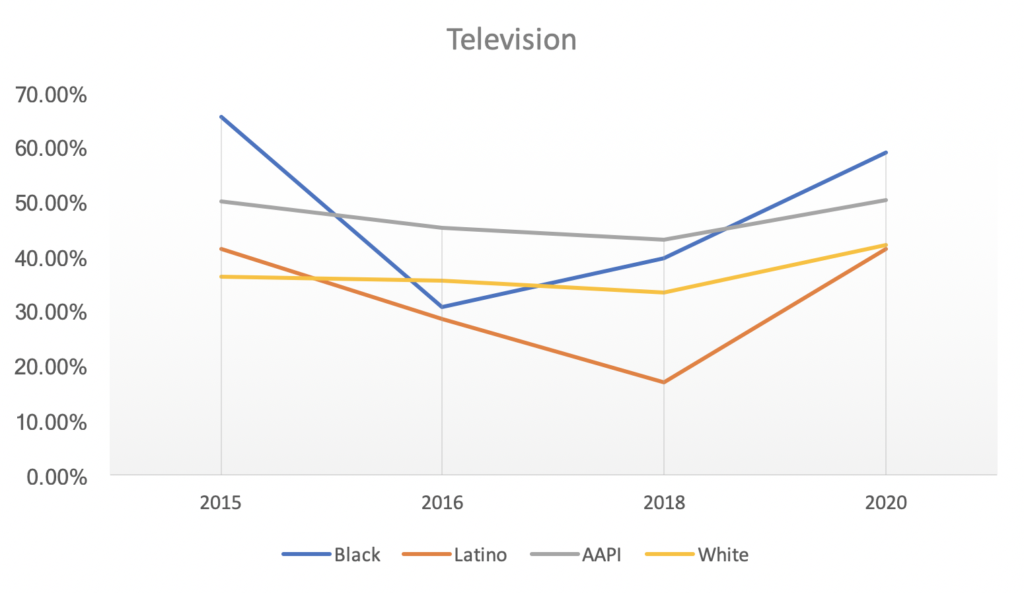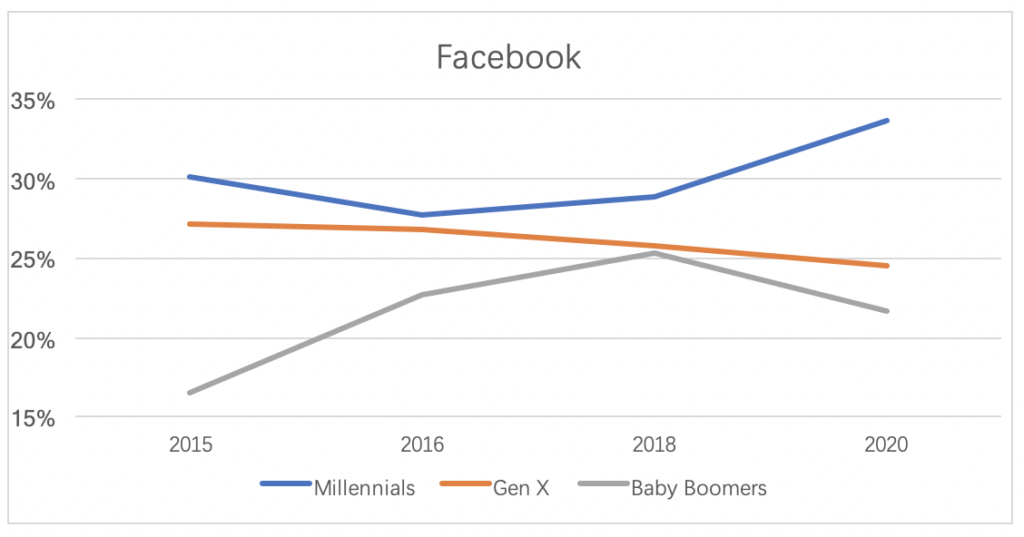Generational Differences in Political Media Use

By Wenyuan Deng
Intro to Media & American Politics Survey (2015-2018)
The Civic Education Research Lab (CERL) conducted three national surveys—in 2015, 2016, 2018 and 2020—in order to study how media, including traditional and online social media, are affecting people’s opinions and behaviors toward U.S. politics and politicians during presidential and midterm elections. Here we analyzed patterns and trends in media use among generational groups. We divided our respondents into three groups according to their age cohorts using the Pew Research Center’s criteria, which designates Millennials, Generation X and Baby Boomers. We found interesting differences in the media use of these groups across the four surveys.
Key Findings:
- Political information seeking habits vary within different generational groups!
- Millennials are adopting the habit of getting political information from some digital platforms.
- Baby boomers are leading the trend in traditional media. They still are using television and newspaper for political information.
- People are increasingly willing to consider getting news from social media to gain political knowledge.
- All generational groups’ use of social media, especially video sharing sites like YouTube, increased over time
- Facebook is losing its popularity, while Twitter and YouTube are attracting more users over the time.
- Even though Facebook is losing its users, still 1/3 of Millennials are frequently getting political news from this platform, leading the other two generational groups both by 10%.
- Millennials are dominating in the percentage using rate in both Twitter and YouTube, leading Gen X by 10% and Baby Boomers by 20%.
Traditional Media: We identify television, print newspapers, print magazines, and radio as traditional media where US citizens receive political information.
-Television
Television, as the most widely-used communication technology in political campaigns, remains a traditional way to gain information in the internet era. (See Figure 1.) Baby Boomers are the most frequent users of television for politics over the three years. In 2015, the older the generation, the more frequently television is used. 56.4% of Baby Boomers watched television frequently to gain political information compared to 44.6% of Generation Xers. Millennials did not use television very often, as only 33.3% of them used television frequently. The trend was almost identical in 2016, where Baby Boomers used television the most and Millennials used television the least. In 2018, Millennials use of television news increased notably, with the percentage rising from 27.2% in 2016 to 44.6%, which surpassed the 41.6% of frequent television use by Gen X. However, in 2020, the millennial is the only generation that is experiencing a decrease in the use of television from 44.6% to 39.7%. The drop gives Gen X an advantage in television use where they are still increasing constantly from 41.6% to 49.2%. Baby Boomer is the all-time leader with their new percentage to 61.8%.
Figure 1

-Print Newspapers
Print newspaper is a very “old-fashioned” technology whose presence has diminished greatly today. (See Figure 2.) In the year of 2015, not surprisingly, 19.5% of Baby Boomer used newspaper frequently to gain political information. This older generation read newspapers more than younger age cohorts. Gen Xers and Millennials exhibited very similar patterns, with about 10.5% of these groups using print papers frequently. The trend for Baby Boomers did not change much over time. Boomers took the lead position among all three generations, even as the number dropped to 13% in 2016. The other two generations were tied at about 9.5% in that year. Two years later, the Baby Boomers were still leading in newspaper readership, but the percentage of Millennials frequently using print papers rose to almost the same level. Gen X consistently had about 8% frequent users in 2018. In 2020, all three generations’ use of newspaper are still constantly increasing. The percentage for Baby Boomer is still the highest among the three generational categories, with the rate of 18.6%. Millennials are in the second place with the rate of 15.8%, and Gen X has the lowest rate of 11.2% just like the previous 3 years.
Figure 2

Online Social Media: We examine respondents’ political use of specific social media platforms, including Facebook, Twitter, and YouTube
Facebook, as the world’s largest social media platform, has become a news site, as citizen journalists use the platform to share stories and users post news items. (See Figure 3.) Younger generations, like Millennials and Gen Xers, are more likely to use Facebook to gain knowledge about politics than older cohorts. In 2015, around one-third of members of these two generations frequently used Facebook for news. 30.1% of Millennials and 27.2% of Generation Xers used the platform frequently for news compared to only 16.5% of Baby Boomers. In the 2016 presidential election cycle, the rate for Millennials and Gen X remained at a high level. The percentage of frequent users of Facebook for news for Millennials was 27.7% and Gen X was 26.8%. The rate for Baby Boomers actually increased a lot to 22.7% frequent users. In the following election cycle, the rate for the two younger generations stayed almost identical at 28.9% for Millennials and 25.9% for Gen X. We might predict that the people who use Facebook as a source of news will continue rising, especially as the rate of Baby boomers using Facebook increased to 25.3% in 2018. In 2020, the use rate for Millennials increases sharply from 28.9% to 33.7%. On contrast, the percentages for both Baby Boomers and Gen X have dropped. The decrease is slight for Gen X compared to 2018 from 25.8% to 24.5%, while downward line is more significant for Baby Boomers compared to the previous year with 25.3% to 21.7%. With that being shown, the frequently use of Facebook in acquiring political information for Millennials has a 10% lead compared to the other two generational groups.
Figure 3

Twitter also has emerged as a platform that disseminates political news. The platform’s architecture of following users attracts people to join Twitter. (See Figure 4.) In 2015, there was not much of a generation gap in the user rate. 16.8% of Millennials, 14.0% of the Gen X and 12.9 of Baby Boomers frequently used Twitter as a source of political information. As more people started to use Twitter as a political news source in 2016, the rate of increase across generations differed. 20.8% of Millennials, 19.4% of Gen Xers and 15.7% of Baby Boomers reported that they frequently used Twitter as a source of news. In the following election cycle, the percentage of Millennials who frequently used Twitter for politics jumped to 27.2%, while Gen Xers’ Twitter use also increased to 20.2%. For Baby Boomers, the rate lowered slightly to 14.1%. In 2020, the percentages have increased for all of the three generational categories. The use rate for Millennials balloons from 27.2% in the previous year to 35.2%. The rate for Gen X gets to the level of 25.6 % and 16.1% for Baby Boomers. The percentages among three generations are slight in the starting point of 2015, but now Millennials are leading 10% to Gen X and 20% to Baby Boomers.
Figure 4

-YouTube
YouTube is a video sharing site under Google. It began as primarily an entertainment website. Now since cable companies have set up their own channels on YouTube, the site has become a more political site for people who only watch a part of or “the cut” of the news programs. (See Figure 5.) In 2015, 14% of Millennials and 11.1% of Gen X frequently went to YouTube to seek political information, while only 4.5% of Baby Boomers did the same. In 2016, the rate of frequent users for all three generations increased, especially for Baby Boomers. The frequent use rate for Baby Boomers went up to 13.2% while the other generations had a fairly flat growth rate. The rate for Millennials was 19.8% and for Gen X was 13.2%. In 2018, Millennials kept their upward trend, reaching a rate of 26.4%. 15.2% of Gen Xers and 13.5% of Baby Boomers watched political videos on YouTube frequently. In 2020, Millennials are extending their advantage among Gen Xers and Baby Boomers. They have a using rate of 30.2% and are leading Gen X by 10% (=20.3%)and Baby Boomers by almost 20% (=13.4%).
Figure 5

